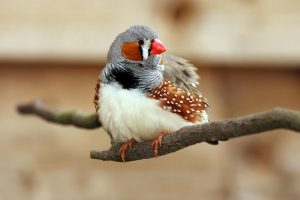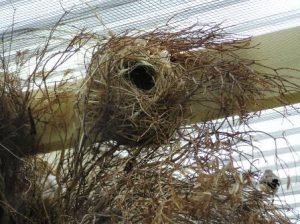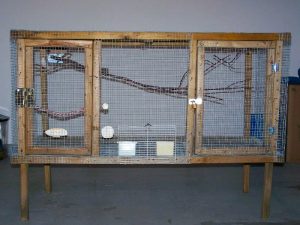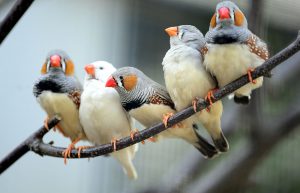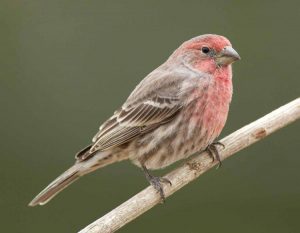Finches
Finches are small passerine birds characterized by their somewhat pointed wings, forked or furrowed tails, round heads, and conical beaks. Although some members of the finch family do not react well to being kept in captivity, many species, including the society, zebra, spice, and blue finches, are commonly kept as pets worldwide for their sweet songs and relative ease of maintenance.
Types of Finches
Despite belonging to the finch family, the following list does not include any canaries.
- Blue Finch
- European Greenfinch
- Saffron Finch
- European Goldfinch
- Spice Finch
- Pine Grosbeak
- Blanford’s (Crimson) Rosefinch
- Common Chaffinch
- Society Finch
- Owl Finch
- Gray Singing Finch
- Strawberry Finch
- Shaft-tail Finch
- Gouldian Finch
- Oriole Finch
- Mongolian Finch
- Golden-naped Finch
- Mountain Finch
- European Linnet
- Star Finch
- Zebra Finch
- Spectacled Finch
- Violaceous Euphonia
- Purple Finch
- House Finch
- Trumpeter Finch
- Desert Finch
- Olive-rumped Serin
- Red-headed Finch
- Java Sparrow
- Cordon Bleu Waxbill
- Diamond Firetail
Distribution and Habitat
These birds have a global distribution, inhabiting Eurasia, Africa, and the Americas, being absent only in the Polar Regions and Australia. Finches are common in well-wooded areas but can also be seen in mountainous and desert habitats, most species being non-migratory in nature.
Lifespan: How Long Do Finches Live
Most finches live for around 5-10 years but can live longer with proper care. Some individuals have lived for 27 years.
Finches as Pets
Housing & Cage Requirements
Finches do a lot of flying within their cage, so ensure you get a large enough cage, at least 30x18x18 inches (Length x Width x High) for a pair. It should be placed in a draft-free, well-ventilated area, away from doors and windows. The ideal temperature for a finch to thrive in is around 60°-70° F (15.5°-21°C) during the day, and around 40°F (4°C) in the night. You may need to cover the cage after dark to ensure a good night’s sleep.
Cage Accessories: There should be a sufficient number of softwood perches of varying textures. An additional benefit of these is that they keep the nails in proper condition. You may also put a cuttlebone to ensure strong beaks and hard eggshells during breeding.
General Care Tips
- Clean the cage on a weekly basis, and disinfect it once every month.
- Replace the food and water dishes every day, putting in new ones.
- Bathe your finch at least once weekly (preferably daily during the summer).
Diet: What to Feed Your Finches
Make sure to provide a well-balanced diet containing fresh and pelleted foods.
Behavior & Temperament
Finches are easy-going birds that would not take up much of your time. They are cheerful, active, entertaining, and robust. Unlike parrots, finches are perfectly content in each other’s company when they do not get much interaction with their owner. They do not like to be handled, but hand-reared finches can get attached to their humans enough to be trained to come and sit on the fingers on cue.
Sounds and Singing: Most finches are quiet birds; however, some species can sing, including canaries, European goldfinches, and house finches. Their sounds are sharp chirps, made most when they are in a group or with other birds. However, they do not make too much sound to render them unsuitable to be kept in an apartment.
Diseases & Health Problems
Finches are usually tough little birds unlikely to face many health concerns; However, an improper diet and care, coupled with a drafty and unhealthy environment with dirty cages, can lead to some problems, including overgrown beaks and nails, feather picking, ingrown feathers, heat stroke, and cramps.
Some of the telltale signs of a finch in ill health are:
- Lack of appetite
- Ruffled feathers
- Sitting with eyes closed
- Head tucked into the wing
- Irregular breathing
Contact a vet as soon as possible if you suspect any of the above signs, as treating any ailment at the earliest is essential.
Interesting Facts
- Perhaps the most well-known member of the finch family is the canary, owing its fame to the animated character Tweety.
- The house finch was initially found only in the western United States before the 1940s. They were illegally brought to New York, and some escaped and thrived in and around Long Island before spreading throughout the country.
Price
The cost of finches can vary exponentially based on the availability and color of the bird. However, they are usually rather inexpensive compared to many parrots, with prices ranging from USD 20 to USD 500.



